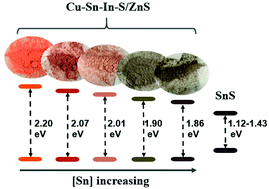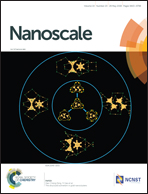Achieving deep-red-to-near-infrared emissions in Sn-doped Cu–In–S/ZnS quantum dots for red-enhanced white LEDs and near-infrared LEDs†
Abstract
Semiconductor quantum dots (QDs) are promising luminescent materials for use in lighting, display and bio-imaging, and the color tuning is a necessity for such applications. In this work, we report tunable colors and deep-red or near infrared (NIR) emissions in Cu–In–S and Cu–In–S/ZnS QDs by incorporating Sn. These QDs (with a size of 5 nm) with varying Sn concentrations and/or Cu/In ratios were synthesized by a non-injection method, and characterized by a variety of analytical techniques (i.e., XRD, TEM, XPS, absorption, photoluminescence, decay time, etc.). The Cu–Sn–In–S and Cu–Sn–In–S/ZnS QDs with Cu/In = 1/2 show the emission maximum in the ranges of 701–894 nm and 628–785 nm, respectively. The red-shift in emission is ascribed to the decrease of the band gap with the Sn doping. The highest quantum yield of 75% is achieved in Cu–Sn–In–S/ZnS with 0.1 mmol Sn and Cu/In = 1/2. Both the white and NIR LEDs were fabricated by using Cu–Sn–In–S/ZnS QDs and a 365 nm LED chip. The white LED exhibits superhigh color rendering indices of Ra = 97.2 and R9 = 91 and a warm color temperature of 2700 K. And the NIR LED shows an interesting broadband near-infrared emission centered at 741 nm, allowing for applications in optical communication, sensing and medical devices.



 Please wait while we load your content...
Please wait while we load your content...